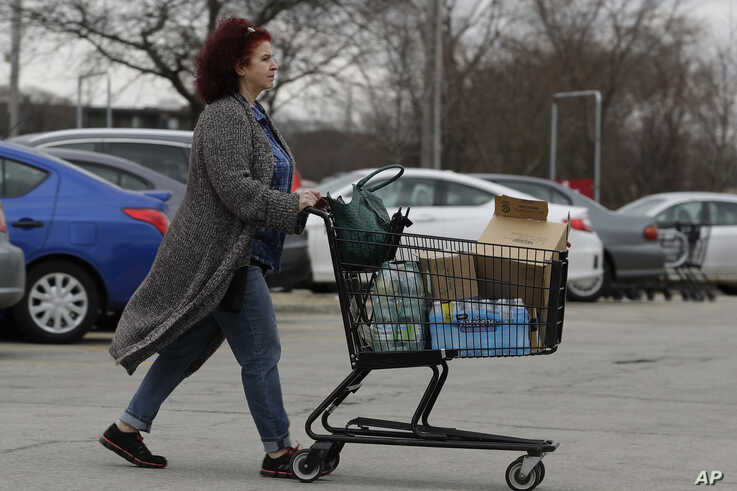Is it Safe to Eat Out, Grocery Shop in the Age of Coronavirus?

A shopper wheels her cart full of groceries in Skokie, Ill., Saturday, March 14, 2020. (AP Photo/Nam Y. Huh)
VOA News By Dora Mekouar
Share on FacebookShare on TwitterShare via EmailPrint this page
Several U.S. states are closing dine-in restaurants and bars, limiting the establishments to carry-out or delivery service, in an effort to stem the spread of coronavirus.
The governors of California, Connecticut, Ohio, Illinois, New York, New Jersey, Massachusetts and Washington State are among those who have ordered the restrictions. Mayors in some towns across the United States are also putting similar measures in place.
«These are very difficult decisions, but hours count here and very strong measures are necessary to slow the spread of the virus,» Washington state Governor Jay Inslee said.

Ben Chapman, a professor and food safety specialist at North Carolina State University, says it is important for people to remember that, when it comes to coronavirus, the risks of eating out have nothing to do with the food itself.
“I’m worried about someone coughing on surfaces, but food itself has not been identified at all as a risk factor in this outbreak,” Chapman says. “Eating food, handling food, has not been identified as a risk factor in this outbreak, or in any other respiratory virus outbreak.”
Health experts are still trying to get a full grasp on how COVID-19 spreads.
The Centers for Disease Control reports the virus is spread primarily from person to person through droplets that are produced when an infected person coughs or sneezes. It is also possible that a person can get coronavirus from surfaces or objects that have the virus on it.
Which means practicing good hygiene is important for those who do go to restaurants right now.
“I, typically, am going to have a menu and I’m going to order food from that menu and what I would suggest is, since I don’t know who’s maybe handled that menu before, after I handle a menu — go wash my hands or use hand sanitizer,” says Chapman. “And I would apply that same step to handling condiments on the table or salt and pepper shakers. I really could reduce my risk of not just coronavirus, but influenza as well.”

The National Restaurant Association has issued guidelines advising eating establishments in the U.S. on steps they can take to avoid spreading coronavirus. These measures include wiping surfaces down more often and using a list of disinfectants that, according to the Environmental Protection Agency, are effective against coronavirus.
“State and local food codes establish strict safe food handling requirements for restaurants,» Larry Lynch, senior vice president of science and industry for the National Restaurant Association told VOA via email. «And operators are being proactive by stepping up existing cleaning and sanitation procedures.”
An area of concern for both restaurants and grocery stores is self-serve food bars where utensils are regularly shared. Chapman advises establishments to regularly clean or swap out shared serving utensils.
“I think that restaurants and grocery stores are taking notice of these common high-touch surfaces and best practice would be to clean and sanitize, and/or replace those in at an interval that matches how often they’re being used,” Chapman says. “That’s where it gets a little tough and you kind of have to look at it business by business.”
While people can avoid restaurants if they choose to, most will have to eventually go to the grocery store to buy food.

While the primary risk factor is being around sick people, there is a contamination concern about hard surfaces like grocery carts, tongs and self-serve areas, sliding doors where refrigerated foods are kept, door handles, and going to the restroom. Shoppers can manage that risk by washing their hands, not touching their face, and using hand sanitizer.
But what if someone infected with coronavirus sneezes in the produce department where many fruits and vegetables are displayed out in the open?
“Even though something like an apple seems like a really hard surface, there are a lot of biological components that can make it not the greatest surface for a virus to survive on,” Chapman says. “The fact that someone even coughs on my food is gross, but doesn’t really, at this point, increase my risk of getting coronavirus because I’m going to eat that produce, and it’s going to go into the high acids environment in my stomach.”
And if even carry-out food is a worry for some people, Chapman says consumers can take proper precautions.
“If I’m worried about something on a package or on a bag, as soon as I’m finished touching that bag, before I touch my food, I will wash my hands and use hand sanitizer,” he says. “Do not think that you’re not in control of the risk because you do have a step to reduce your individual risk.”

